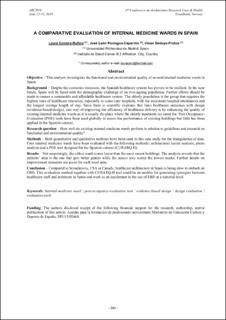| dc.contributor.author | Cambra-Rufino, Laura | |
| dc.contributor.author | Paniagua-Caparrós, José León | |
| dc.contributor.author | Bedoya-Frutos, César | |
| dc.date.accessioned | 2022-01-31T19:30:55Z | |
| dc.date.available | 2022-01-31T19:30:55Z | |
| dc.date.issued | 2021 | |
| dc.identifier.isbn | 978-82-536-1718-3 | |
| dc.identifier.issn | 2387-4295 | |
| dc.identifier.uri | https://hdl.handle.net/11250/2976138 | |
| dc.description.abstract | Objective – This analysis investigates the functional and environmental quality of several internal medicine wards in Spain.
Background – Despite the economic recession, the Spanish healthcare system has proven to be resilient. In the near future, Spain will be faced with the demographic challenge of an ever-ageing population. Further efforts should be made to ensure a sustainable and affordable healthcare system. The elderly population is the group that requires the highest rates of healthcare resources, especially in acute-care hospitals, with the maximum hospital attendances and the longest average length of stay. Since there is scientific evidence that links healthcare outcomes with design (evidence-based-design), one way of improving the efficiency of healthcare delivery is by enhancing the quality of existing internal medicine wards as it is usually the place where the elderly inpatients are cared for. Post-Occupancy- Evaluation (POE) tools have been used globally to assess the performance of existing buildings but little has been applied in the Spanish context.
Research question – How well do existing internal medicine wards perform in relation to guidelines and research on functional and environmental quality?
Methods – Both quantitative and qualitative methods have been used in this case study for the triangulation of data. Four internal medicine wards have been evaluated with the following methods: architectural layout analysis, photo analysis and a POE tool designed for the Spanish context (CURARQ-H).
Results – Not surprisingly, the oldest ward scores lower than the most recent buildings. The analysis reveals that the patients’ area is the one that gets better grades while the access area scores the lowest marks. Further details on improvement measures are given for each ward area.
Conclusion – Compared to Scandinavia, USA or Canada, healthcare architecture in Spain is being slow to embark on EBD. This evaluation method together with CURARQ-H tool could be an enabler for generating synergies between healthcare staff and architects in Spain and work as an accelerator in the use of EBD at a national level. | |
| dc.language.iso | eng | |
| dc.publisher | SINTEF Academic Press | |
| dc.relation.ispartof | ARCH19 June 12–13, 2019 – Trondheim, Norway. Proceedings from the 4th Conference on Architecture Research Care & Health | |
| dc.relation.ispartofseries | SINTEF Proceedings;8 | |
| dc.rights | CC BY 4.0 | |
| dc.rights.uri | https://creativecommons.org/licenses/by/4.0/ | |
| dc.subject | Internal-medicine ward | |
| dc.subject | Post-occupancy-evaluation tool | |
| dc.subject | Evidence-based design | |
| dc.subject | Evaluation tool | |
| dc.subject | Design evaluation | |
| dc.title | A comparative evaluation of internal medicine wards in spain | |
| dc.type | Chapter | |
| dc.type | Peer reviewed | |
| dc.type | Conference object | |
| dc.description.version | publishedVersion | |
| dc.rights.holder | © 2021 The Authors. Published by SINTEF Academic Press. | |

